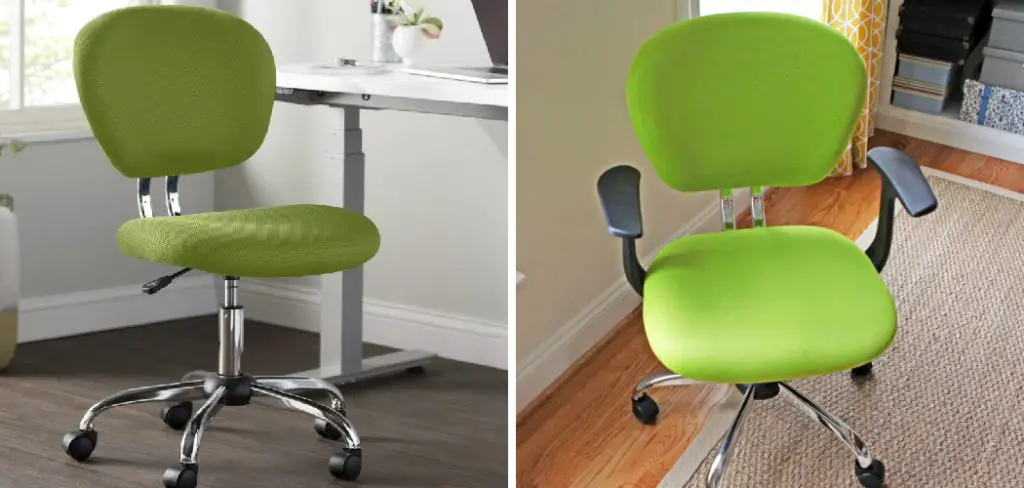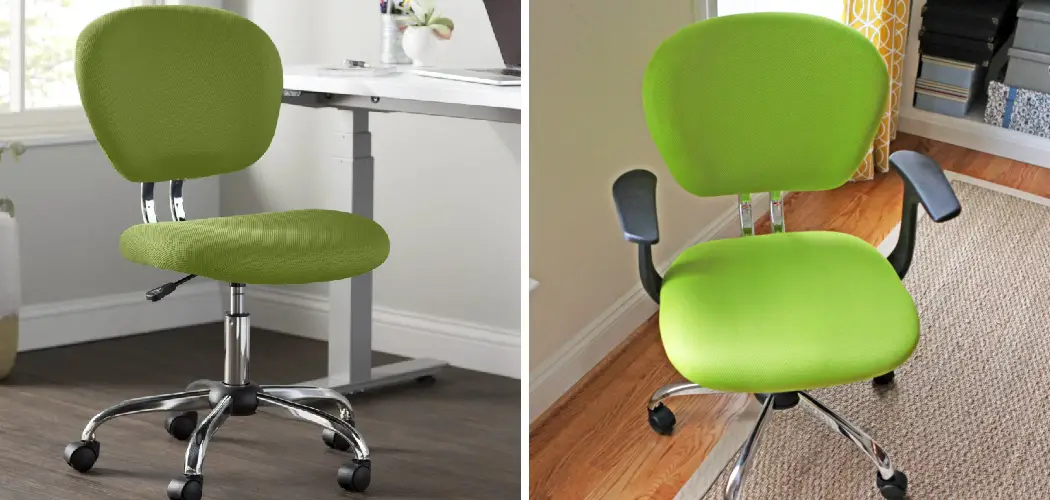Swivel chairs are a common feature in homes and offices, offering comfort and flexibility for daily tasks.

However, over time, the moving parts of a swivel chair can wear down, leading to squeaks, stiffness, or a reduction in smooth movement. Regular lubrication is essential to maintain the chair’s functionality and extend its lifespan.
In this guide on how to lubricate swivel chairs, we’ll walk you through the steps to properly lubricate your swivel chair, keeping it in optimal working condition.
Why Lubricate Swivel Chairs?
Lubricating your swivel chair is necessary because it helps to reduce friction between the moving parts of the chair. This prevents wear and tear, which can lead to stiffness and squeaks. Regular lubrication also helps to maintain smooth movement, making it easier to turn and adjust the chair as needed.
It is important to note that not all swivel chairs require lubrication. Some may have sealed bearings or self-lubricating mechanisms, which means they do not need additional lubrication. Check with the manufacturer or refer to the chair’s manual before attempting to lubricate it.
What You Will Need
- Lubricant Spray or Oil (Such as Silicone or Teflon-based Lubricants)
- Cloth or Paper Towels
- Wrench or Pliers (Depending on the type of Swivel Chair)
8 Step-by-step Guides on How to Lubricate Swivel Chairs
Step 1: Preparation
Before you begin lubricating your swivel chair, it’s essential to prepare the area and gather your tools. Start by placing the chair in a well-lit, spacious area where you can comfortably work. Lay down a drop cloth or old newspaper underneath the chair to protect your floor from any accidental spills.

Ensure you have all the necessary tools and materials ready, including the lubricant spray or oil, a clean cloth, and any tools required to access the chair’s moving parts, such as a wrench or pliers. Finally, inspect the chair for visible dust, rust, or debris, as these may need to be cleaned off before applying the lubricant.
Step 2: Identify the Moving Parts
To effectively lubricate your swivel chair, you need to locate all the moving parts that require lubrication. These typically include the swivel mechanism at the base of the chair, any exposed bearings, and the rotating joint between the seat and the base. Carefully inspect the chair by tilting it or turning it upside down to get a clear view of these components.
If your chair has a reclining function or adjustable armrests, check for additional moving joints in those areas. Identifying these parts ensures that you apply lubricant precisely where it is needed for optimal performance.
Step 3: Clean the Moving Parts
Before applying any lubricant, it is crucial to clean the moving parts to remove any dust, debris or rust that may have accumulated. Use a clean cloth or paper towel to wipe away any visible dirt or grime carefully. If there is significant build-up in these areas, you may need to use a mild detergent and water solution to thoroughly clean them before proceeding.
But be careful not to use abrasive cleaners or harsh chemicals, as they could damage the chair’s finish.
Step 4: Choose the Right Lubricant
When it comes to lubricating your swivel chair, you have a variety of options, including silicone-based sprays and oils specifically designed for mechanical parts. These lubricants provide superior protection against friction and usually come with an applicator nozzle for precise application.
Avoid using general-purpose oil or greases as they can attract dust and dirt, leading to more frequent maintenance needs. Also, ensure you read the manufacturer’s instructions on the lubricant before applying it to your swivel chair.

Step 5: Spray or Apply Lubricant
Once you have identified the moving parts and cleaned them, it’s time to apply the lubricant. If using a spray, ensure you shake the can well before application. Then, in a well-ventilated area, point the nozzle at the moving parts and spray an even layer of lubricant over them.
If using oil, apply a small amount directly onto each moving part or use a cloth to rub it evenly into those areas. Avoid over-saturating any parts with too much lubricant as this can attract dirt and cause messier application.
Step 6: Move and Rotate
After applying the lubricant, move and rotate the chair to allow it to penetrate all the joints thoroughly. This will help distribute the lubricant evenly and ensure all parts are sufficiently covered.
You may also need to adjust certain settings, such as reclining or armrests, to fully work in the lubricant. However, avoid forcing any movements if they feel stiff or difficult, as this could indicate a more significant issue that requires professional attention.
Step 7: Wipe Away Excess Lubricant
After moving and rotating the chair to distribute the lubricant, use a clean cloth or paper towel to wipe away any excess lubricant from the moving parts. This step is important to prevent the lubricant from dripping onto the floor or attracting dust and debris over time.
Ensure all visible excess lubricant is thoroughly removed, but be careful not to wipe too much from the areas that need it, as this can reduce its effectiveness. Once the excess has been cleaned, inspect the chair for any missed spots and reapply the lubricant if necessary.
Step 8: Test the Chair
The final step is to test your newly lubricated swivel chair. Sit on it and adjust its various settings to ensure smooth movement without any squeaks or stiffness. If you notice any issues, identify the problem area and reapply lubricant as needed.

Regularly testing and using your swivel chair will provide a good indication of when it needs re-lubrication, typically every 6-12 months, depending on usage. In addition to regular maintenance, keep an eye out for any signs of wear or damage to the moving parts, which may need professional attention.
Following these step-by-step guides on how to lubricate swivel chairs will keep your chair functioning smoothly and extend its lifespan. Regular maintenance also ensures you have a comfortable and ergonomically friendly seating experience. Happy lubricating!
Additional Tips
- If you notice any unusual sounds or stiffness in your swivel chair, it may be a sign that it needs lubrication.
- Avoid using WD-40 as a lubricant for your swivel chair as it can attract dirt and cause more issues.
- If your swivel chair has been unused for an extended period, consider reapplying lubricant before regular use to prevent stiff movements.
- For extra protection against rust, consider wiping down the metal parts of your swivel chair with a light layer of petroleum jelly after lubricating them.
- Regular cleaning and maintenance of your swivel chair can also help extend its lifespan and prevent the need for frequent lubrication.
- If you are unsure about how to apply lubricant or are experiencing persistent issues with your swivel chair, seek professional assistance.
Frequently Asked Questions
Q: How Often Should I Lubricate My Swivel Chair?
A: Lubricate your swivel chair every 6-12 months, depending on usage. It’s also good practice to regularly check for any signs of wear or damage to the moving parts and re-lubricate as needed.
Q: Can I Use General-Purpose Oil or Grease?
A: It is not recommended to use general-purpose oil or grease on your swivel chair, as they can attract dust and dirt, leading to more frequent maintenance needs. Instead, opt for lubricants specifically designed for mechanical parts such as silicone-based sprays or oils.
Q: Is There a Special Way To Apply Lubricant?
A: When applying lubricant, ensure you follow the manufacturer’s instructions carefully. If using a spray, shake the can well before application and aim a nozzle at the moving parts. If using oil, apply a small amount directly onto each moving part or use a cloth to rub it evenly into those areas.
Q: What Do I Do If My Swivel Chair Is Still Stiff After Lubrication?
A: If your swivel chair is still stiff or difficult to move after lubrication, it could indicate a more significant issue that requires professional attention. Avoid forcing any movements and consult with a professional for further assistance. Remember to regularly test and use your swivel chair to catch any issues early on. Always prioritize safety and seek expert help if needed.

Conclusion
Properly maintaining your swivel chair through regular cleaning and lubrication is essential for ensuring its longevity and optimal performance. By following the step-by-step guide on how to lubricate swivel chairs provided, you can prevent common issues such as squeaks, stiffness, and premature wear of the moving parts. Not only does this enhance the functionality of your chair, but it also contributes to a more comfortable and ergonomic seating experience.
Incorporating these maintenance practices into your routine every 6-12 months will keep your swivel chair in excellent condition for years to come. Remember, a well-maintained chair can improve both your productivity and overall well-being.

